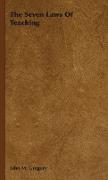The Seven Laws of Teaching
BücherAngebote / Angebote:
THE SEVEN LAWS OF TEACHING by JOHN M. GREGORY. Originally published in 1886. Train up a child in the way he should go and when he is old he will not depart from it. , Why is it that we, the elder, are spared to the world, except to train up and instruct the young It is impossible that the gay little folks should guide and teach themselves, and accordingly God has committed to us who are old and experienced the knowledge which is needful for them, and he will require of us a strict account of what we have done with it. Martin Luther. Faith in God is the source of peace in life peace in life is the source of inward order inward order is the source of the unerring application of our powers, and this again is the source of the growth of those powers, and of their training in wisdom wisdom is the spring of all human blessings. Pestalosti. If you follow nature, the education you give will succeed without giving you trouble and perplexity especially if you do not insist upon acquirements precocious or over-extensive, Plato. It should not be claimed that there is no art or science of training up to virtue. Remember how absurd it would be to believe that even the most trifling employment has its rules and methods, and at the same time, that the highest of all departments of human effort virtue can be mastered without instruction and practice 1 Cicero. Contents include: i. THE LAWS OF TEACHING . , . 11. THE LAW OF THE TEACHER 15 in. THE LAW OF THE LEARNER 28 IV. THE LAW OF THE LANGUAGE 48 v. THE LAW OF THE LESSON ... 65 VI. THE LAW OF THE TEACHING PROCESS 81 VII. THE LAW OF THE LEARNING PROCESS 104 VIII. LAW OF REVIEW . .. 118 INTRODUCTION: LET us, like the Master, place a little child in our midst Let us carefully observe this child that we may learn from it what education is for education, in its broadest meaning, embraces all the steps and processes by which an infant is gradually transformed into a full grown and intelligent man. Let us take account of the child as it is. It has a complete human body, with eyes, hands, and feet, all the organs of sense, of action and of locomotion, and yet it lies helpless in its cradle. It laughs, cries, feels, and seems to perceive, remember, and will. It has all the faculties of the human being, but is without power to use them save in a merely animal way. In what does this infant differ from a man Simply in being a child. Its body and limbs are small, weak, and without voluntary use. Its feet can not walk. Its hands have no skill. Its lips can not speak. Its eyes see without per ceiving 5 its ears hear without understanding. The universe into which it has come lies around it wholly unseen and unknown. As we more carefully study all this, two chief facts become dear First, this child is but a germ it has not its destined growth. Second, it is ignorant without acquired ideas. On these two facts rest the two notions of education. l The development of powers. 2 The acquisition of knowledge. The first is an unfolding of the faculties of body and mind to full growth and strength the second is the furnishing of the mind with the knowledge of things of the facts and truths known to the human intelligence. vi Introduction Each of these two facts the childs immaturity and its ignorance might serve as a basis for a science of educa tion. The first would include a study of the faculties and powers of the human being, their order of development and their laws of growth and action. The second would involve a study of the various branches of knowledge and arts with their relations to the faculties by which they are discovered, developed, and perfected. Each of these sciences would necessarily draw into sight and involve the other just as a study of powers involves a knowledge of their products, and as a study of effects includes a survey of causes...
Folgt in ca. 15 Arbeitstagen

